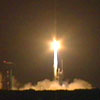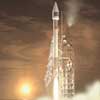|
Sunday:
December 21, 2003 | |
0947 GMT |
 |
Boeing Delta 2 rocket soars with GPS satellite
Leaving behind its chilly Florida launch pad, a Boeing Delta 2 rocket lifted off on-time at 2:50 a.m. EST (0750 GMT) this morning to place the next Global Positioning System satellite into orbit. Follow the mission in our status center:
 MISSION STATUS CENTER MISSION STATUS CENTER
 |  |

|
 |
Engine, parachute tests pave way for launch escape
NASA has tested rocket engines and parachutes that could be instrumental in developing the first spacecraft crew launch escape system in almost 30 years. The tests pave the way for a series of integrated Pad Abort Demonstration test flights to support NASA's Orbital
Space Plane program.
 FULL STORY FULL STORY
 |  |

|
 |
Celestial illumination: X-ray glow from an exploded star
NASA's Chandra X-ray Observatory has imaged the glowing shell created by the destruction of a massive star. X-rays from Chandra (blue), combined with optical (green) and radio (red) data, reveal new details in the supernova remnant known as N63A, located in the nearby galaxy of Large Magellanic Cloud.
 FULL STORY FULL STORY
 |  |

|
 |
|
Saturday:
December 20, 2003 | |
0128 GMT |
 |
New GPS satellite ready for Sunday morning liftoff
A Boeing Delta 2 rocket and its Global Positioning System 2R-10 satellite payload are poised for liftoff at 2:50 a.m. EST (0750 GMT) Sunday from Cape Canaveral, Florida. The new spacecraft will strengthen the U.S. military's GPS constellation that guides planes, ships, troops and precision weaponry.
 MISSION STATUS CENTER - updates MISSION STATUS CENTER - updates
 PREVIEW STORY PREVIEW STORY
 |  |

|
 |
Rover wheels to dig holes for Martian soil study
After the twin Mars Exploration Rovers bounce onto the red planet and begin touring the Martian terrain in January, onboard spectrometers and cameras will gather data and images --- and the rovers' wheels will dig holes.
 FULL STORY FULL STORY
 |  |

|
 |
|
Friday:
December 19, 2003 | |
1600 GMT |
 |
Beagle 2 released to hunt for life on Martian surface
With the Christmas Day arrival at the Red Planet fast approaching, the tiny British Beagle 2 lander was successfully cast free from the Mars Express space probe Friday. Beagle 2 is bound for surface to conduct a host of experiments including some to look for evidence of past life.
 FULL STORY - updated with deploy image FULL STORY - updated with deploy image
 |  |

|
 |
First images from Spitzer Space Telescope unveiled
NASA unveiled the first images from the $670 million Spitzer Space Telescope Thursday, spectacular infrared glimpses of the optically-hidden heart of a distant galaxy, the dusty cradle of an infant solar system and a peek at heretofore unseen stars lurking inside a vast cloud of gas and dust.
 FULL STORY FULL STORY
 |  |

|
 |

Video coverage for subscribers only:
 VIDEO: SCIENCE RESULTS ARE ANNOUNCED IN 55-MINUTE BRIEFING QT VIDEO: SCIENCE RESULTS ARE ANNOUNCED IN 55-MINUTE BRIEFING QT
 ADDITIONAL VIDEO COVERAGE ADDITIONAL VIDEO COVERAGE
 SUBSCRIBE NOW SUBSCRIBE NOW

|
NASA's last Great Observatory renamed
The Space Infrared Telescope Facility has been renamed the Spitzer Space Telescope. It was named in honor of the late Dr. Lyman Spitzer Jr., one of the 20th century's most distinguished scientists.
 FULL STORY FULL STORY
 SPITZER BIOGRAPHY SPITZER BIOGRAPHY
 |  |

|
 |

Video coverage for subscribers only:
 VIDEO: WATCH CEREMONY NAMING THE SPITZER SPACE TELESCOPE QT VIDEO: WATCH CEREMONY NAMING THE SPITZER SPACE TELESCOPE QT
 ADDITIONAL VIDEO COVERAGE ADDITIONAL VIDEO COVERAGE
 SUBSCRIBE NOW SUBSCRIBE NOW

|
Rocket launch to bolster GPS satellite constellation
A replacement satellite ascends into space this weekend to strengthen the U.S. military's Global Positioning System -- a constellation of orbiting spacecraft that guides planes, ships, troops and precision weaponry. Liftoff of the Boeing Delta 2 rocket from Cape Canaveral is set for 2:50 a.m. EST (0750 GMT) Sunday.
 PREVIEW STORY PREVIEW STORY
 MISSION STATUS CENTER - updates MISSION STATUS CENTER - updates
 |  |

|
 |
IN OTHER NEWS Additional stories making news today
|
 |
XTAR selects Arianespace to launch the XTAR-EUR satellite -- XTAR, a joint venture between Loral Space & Communications and HISDESAT, S.A., announced that it has entered into an agreement with Arianespace to launch its XTAR-EUR satellite aboard an Ariane 5 ECA rocket. The launch is currently planned for early second quarter 2004.

Arianespace to launch Syracuse IIIB -- Alcatel Space has chosen Arianespace to orbit France's new Syracuse IIIB military communications satellite for the French defense procurement agency DGA. Syracuse III will be launched by an Ariane 5 at the end of 2005 from the Guiana Space Center, Europe's Spaceport in Kourou, French Guiana.

Arianespace to launch MSG 3 -- Tillmann Mohr, Director General of Eumetsat, and Jean-Yves Le Gall, Chief Executive Officer of Arianespace, on Dec. 17 signed the launch contract for the MSG 3 weather satellite at the European Space Agency headquarters in Paris. The launch of MSG 3 is scheduled for the first half of 2009 from the Guiana Space Center in Kourou, French Guiana, using an Ariane 5 launch vehicle.
|
 |
|
Thursday:
December 18, 2003 | |
0635 GMT |
 |
Atlas rocket launches on Centennial of Flight
A century after man made the first powered flight -- the Wright brothers' historic achievement that set in motion the realization of aviation and spaceflight dreams -- an American rocket with a Russian-made engine soared successfully Wednesday to put a communications satellite high above Earth.
 FULL STORY FULL STORY
 MISSION STATUS CENTER MISSION STATUS CENTER
 |  |

|
 |

Video coverage for subscribers only:
 VIDEO: THE LAUNCH AS SEEN THROUGH T+PLUS 5 MINUTES QT VIDEO: THE LAUNCH AS SEEN THROUGH T+PLUS 5 MINUTES QT
 VIDEO: AN OVERVIEW OF UHF FOLLOW-ON SATELLITE PROGRAM QT VIDEO: AN OVERVIEW OF UHF FOLLOW-ON SATELLITE PROGRAM QT
 VIDEO: NARRATED ANIMATION PREVIEW OF THIS LAUNCH QT VIDEO: NARRATED ANIMATION PREVIEW OF THIS LAUNCH QT
 VIDEO: ANIMATION OF UHF F11 SATELLITE IN SPACE QT VIDEO: ANIMATION OF UHF F11 SATELLITE IN SPACE QT
 VIDEO: LOOK BACK AT PAST ATLAS LAUNCHES OF UHF CRAFT QT VIDEO: LOOK BACK AT PAST ATLAS LAUNCHES OF UHF CRAFT QT
 VIDEO: PRESIDENT BUSH'S SPEECH AT KITTY HAWK QT VIDEO: PRESIDENT BUSH'S SPEECH AT KITTY HAWK QT
 VIDEO: SPACE STATION CREW MARKS CENTENNIAL QT VIDEO: SPACE STATION CREW MARKS CENTENNIAL QT
 ADDITIONAL VIDEO COVERAGE ADDITIONAL VIDEO COVERAGE
 SUBSCRIBE NOW SUBSCRIBE NOW

|
Mars may be emerging from an ice age
NASA's Mars Global Surveyor and Mars Odyssey missions have provided evidence of a recent ice age on Mars. In contrast to Earth's ice ages, a martian ice age waxes when the poles warm up and water vapor is transported toward lower latitudes. Martian ice ages wane when the poles cool and lock water into polar icecaps.
 FULL STORY FULL STORY
 |  |

|
 |
|
Wednesday:
December 17, 2003 | |
0514 GMT |
 |
Atlas 3B rocket to fly 100 years after Wright Flyer
As the aerospace world marks the Centennial of Flight -- the 100th anniversary of the Wright brothers' first powered flight -- Lockheed Martin will launch its Atlas 3B rocket to put a U.S. Navy communications satellite high above Earth. Liftoff from Cape Canaveral is scheduled for 9:30 p.m. EST (0230 GMT) tonight.
 MISSION STATUS CENTER - live updates! MISSION STATUS CENTER - live updates!
 MONDAY SCRUB STORY MONDAY SCRUB STORY
 LAUNCH PREVIEW STORY LAUNCH PREVIEW STORY
 ASCENT EVENTS TIMELINE ASCENT EVENTS TIMELINE
 GROUND TRACK MAP GROUND TRACK MAP
 FACT SHEET ON NAVY UHF PROGRAM FACT SHEET ON NAVY UHF PROGRAM
 |  |

|
 |
Rocket launch to bolster GPS satellite constellation
A replacement satellite ascends into space this weekend to strengthen the U.S. military's Global Positioning System -- a constellation of orbiting spacecraft that guides planes, ships, troops and precision weaponry.
 PREVIEW STORY PREVIEW STORY
 LAUNCH WEATHER FORECAST LAUNCH WEATHER FORECAST
 |  |

|
 |
Einstein makes extra dimensions toe the line
Scientists say Albert Einstein's principle of the constancy of the speed of light holds up under extremely tight scrutiny, a finding that rules out certain theories predicting extra dimensions and a "frothy" fabric of space.
 FULL STORY FULL STORY
 |  |

|
 |
|
Tuesday:
December 16, 2003 | |
0625 GMT |
 |
Atlas 3 rocket launch postponed until Wednesday
Monday night's shot at launching a Lockheed Martin Atlas 3B rocket carrying the final in a series of U.S. Navy communications satellites was postponed after a device that helps release the booster from its launch pad was subjected to colder-than-allowable temperatures, officials said. Liftoff is tentatively rescheduled for Wednesday night.
 SCRUB STORY SCRUB STORY
 MISSION STATUS CENTER - live updates! MISSION STATUS CENTER - live updates!
 |  |

|
 |
X-ray view of the Red Planet
As the Mars Express spacecraft nears the Red Planet, another European Space Agency mission is turning its gaze towards Mars. This recent X-ray image of the planet was taken by the XMM-Newton observatory.
 FULL STORY FULL STORY
 |  |

|
 |
NASA scientists say spring thaw makes a difference
Using a suite of microwave remote sensing instruments aboard satellites, scientists at NASA's Jet Propulsion Laboratory and the University of Montana, Missoula, have observed a recent trend of earlier thawing across the northern high latitudes.
 FULL STORY FULL STORY
 |  |

|
 |
|
Monday:
December 15, 2003 | |
0001 GMT |
 |
U.S. Navy satellite to launch aboard Atlas 3 rocket
The last in a long line of communications satellites for the U.S. Navy heads for space Monday night aboard a Lockheed Martin Atlas 3B rocket. Launch from Cape Canaveral is scheduled for 9:38 p.m. EST (0238 GMT).
 MISSION STATUS CENTER - updates! MISSION STATUS CENTER - updates!
 LAUNCH PREVIEW STORY LAUNCH PREVIEW STORY
 ASCENT EVENTS TIMELINE ASCENT EVENTS TIMELINE
 GROUND TRACK MAP GROUND TRACK MAP
 FACT SHEET ON NAVY UHF PROGRAM FACT SHEET ON NAVY UHF PROGRAM
 |  |

|
 |
Delta 4-Heavy exposed
The mobile service tower at Cape Canaveral's pad 37B was rolled away from the newly-erected Boeing Delta 4-Heavy rocket for a brief time December 11. This provided the first clear view of the 170-foot tall rocket standing fully exposed on the launch pad.
 ENTER PHOTO GALLERY ENTER PHOTO GALLERY
 |  |

|
 |
Planet rings may live longer by recycling
Although rings around planets like Jupiter, Saturn, Uranus and Neptune are relatively short-lived, new evidence implies that the recycling of orbiting debris can lengthen the lifetime of such rings, according to University of Colorado researchers.
 FULL STORY FULL STORY
 |  |

|
 |

